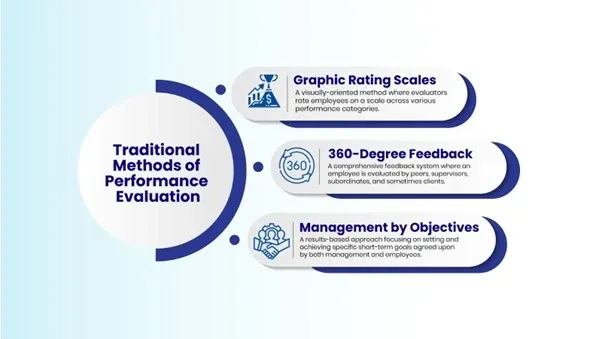Employee Performance Evaluation: Advantages & Techniques | getCREDIBLE

Employee performance evaluation is like a regular check-up on how you're doing at work. Companies invest in performance evaluation frameworks to consistently evaluate and measure employee achievements.
It's a chance to chat about what's going well and what can get even better, with the aim of helping you grow in your role and feel more connected to your team's goals. It's super helpful and encouraging!

Let's understand the importance of performance evaluation with some actual statistics:
- According to Business researcher Josh Bersin, 70% of MNCs have moved from annual to continuous performance evaluation.
- 84% of employees say they feel more involved when they get quick feedback.
- Gartner reveals that 59% of employees believe traditional performance review systems don't affect their personal productivity.
This data highlights the importance of performance evaluation and how companies are constantly working to improve performance evaluation.
Often, people mix performance evaluation with performance management. Performance evaluation is like a snapshot, where you check out how someone's doing at a specific moment. It's about giving feedback on their work. On the other hand, performance management is like a movie, where you continuously work with them to improve and achieve goals. It's all about helping them grow over time.
In this blog, we are going to learn about performance evaluation and different strategies to improve it. Let's go through the benefits of performance evaluation and how it benefits the organizations.
Benefits of Performance Evaluation
Here are some key benefits of performance evaluation, with a focus on how employee feedback naturally plays a role in each point:
- Improvement in Employee Productivity and Motivation: Regular performance evaluations provide employees with valuable feedback on their work, helping them understand their strengths and areas for improvement. This feedback motivates employees to enhance their productivity and efficiency.
- Enhanced Communication Between Employees and Management: Performance evaluations create a structured opportunity for employees and management to engage in open dialogue. Employee feedback during these evaluations can highlight concerns, preferences, and suggestions, fostering a culture of transparency and trust.
- Better Alignment of Individual Goals with Organizational Objectives: Through the process of performance evaluation, employees receive feedback that helps them understand how their individual goals align with the broader organizational objectives. This alignment is crucial for ensuring that everyone is working towards the same vision and that employee efforts contribute effectively to the company's success.
- Identification of Training and Development Needs: One key outcome of performance evaluation is identifying training and development needs. Employee feedback during these evaluations can reveal skill gaps or areas where additional training is required.
Methods of Performance Evaluation in 2024
There are various performance evaluation methods available, and with the rise of digitalization, numerous online tools have emerged to facilitate performance evaluation, especially in remote working environments.
Traditional Methods of Performance Evaluation

Graphic Rating Scales
Graphic rating scales are one of the most common methods of performance evaluation. This approach involves using a scale (e.g., 1 to 5 or 1 to 10) to rate various aspects of an employee's performance, such as quality of work, punctuality, teamwork, and communication skills.
This method really highlights the value of employee feedback. It's excellent because managers can give scores and also share personal comments for each point. This feedback is super helpful for employees to see what they're doing well and where they can grow, which is awesome for their professional development.
360-Degree Feedback
The 360-degree feedback method involves gathering employee feedback from multiple sources, including supervisors, peers, subordinates, and sometimes even clients. This comprehensive approach ensures that the evaluation captures a well-rounded view of the employee's performance.
This method really emphasizes the value of employee feedback. It offers a comprehensive look at a person's skills and behavior. This feedback is beneficial for identifying opportunities for growth and nurturing a culture of constant improvement.
Management by Objectives (MBO)
Management by Objectives (MBO) is a goal-oriented approach to performance evaluation. In this method, employees and their managers jointly set specific, measurable, achievable, relevant, and time-bound (SMART) objectives at the beginning of the evaluation period. Progress is monitored throughout the period, and the achievement of these objectives is evaluated at the end.
Employee feedback is super important in MBO. Regular check-ins and feedback sessions ensure that everyone is on the right path to hitting their goals. This method is great because it aligns individual performance with what the organization wants to achieve and builds a feeling of ownership and responsibility.
Modern Methods of Performance Evaluation

Continuous Feedback Systems
Continuous feedback systems are designed to provide ongoing communication between employees and managers rather than limiting feedback to annual reviews. This approach ensures that employees receive timely and regular feedback on their performance, allowing for immediate adjustments and improvements. These systems really show how vital employee feedback is because they create an environment where everyone can talk openly and keep growing all the time.
OKRs (Objectives and Key Results)
OKRs (Objectives and Key Results) are a goal-setting framework that helps align employee performance with organizational objectives. Employees set specific, measurable goals (Objectives) and track their progress through quantifiable outcomes (Key Results). This method emphasizes the importance of employee feedback in setting realistic goals and adjusting them as needed based on ongoing feedback and changing priorities.
AI and ML based Evaluation Tools
AI and machine learning-based evaluation tools use algorithms to analyze employee performance data and provide insights into areas of strength and improvement. These tools can offer objective assessments, reduce biases, and identify patterns in employee feedback that might not be apparent through traditional methods. The importance of employee feedback is recognized in these tools, as they often incorporate feedback data to enhance the accuracy and relevance of their analyses.
Peer Reviews and Self-Assessments
Peer reviews and self-assessments encourage employees to reflect on their own performance and seek feedback from their colleagues. This method promotes a collaborative environment where employees can learn from each other's perspectives and experiences. This approach really shows how important employee feedback is because it uses the whole team's insights to give a complete picture of how everyone's doing.
Modern Online Tools
There are many online tools designed to streamline the performance evaluation process by providing a platform for gathering and managing employee feedback. One of such tools is getCREDIBLE. These tools enable organizations to collect feedback from various sources, including self-assessments, peer reviews, and manager evaluations, in a structured and efficient manner.
The importance of employee feedback is central to these tools as it facilitates the collection and analysis of feedback to inform performance evaluations and development plans.
Best Practices for Effective Performance Evaluation
- Set Clear and Measurable Goals: Establish clear benchmarks for performance and use regular employee feedback to ensure alignment with organizational objectives.
- Foster Open Communication: Create an environment where employees feel comfortable giving and receiving feedback, highlighting its importance in the evaluation process.
- Provide Regular Constructive Feedback: Offer ongoing feedback to keep employees informed about their performance and areas for improvement.
- Use Diverse Evaluation Methods: Employ a variety of methods, such as peer reviews and self-assessments, to gather comprehensive employee feedback.
- Focus on Development: Emphasize identifying opportunities for growth and development based on employee feedback.
- Ensure Fairness and Objectivity: Minimize biases and base evaluations on factual data, incorporating structured employee feedback to maintain fairness.
- Document and Follow-Up: Record evaluation outcomes and follow up on action plans, using employee feedback to track progress and reinforce continuous improvement.
Integrating Technology into Performance Evaluation
The integration of technology into performance evaluation has revolutionized the way organizations conduct this crucial process. Here's how technology, particularly HR software and data analytics, plays a role in enhancing performance evaluation:
Role of HR Software and Platforms
HR software and platforms have become indispensable tools in streamlining the performance evaluation process. These platforms provide a centralized repository for employee feedback, performance data, and evaluation results. They facilitate seamless communication between employees and managers, ensuring that feedback is documented and accessible for future reference. Additionally, these tools often come with built-in templates and workflows that guide managers through the evaluation process, making it more efficient and consistent across the organization.
Use of Data Analytics and AI
Data analytics and artificial intelligence (AI) are transforming the way performance evaluations are conducted by providing more objective and data-driven assessments. By analyzing employee feedback and performance data, AI algorithms can identify patterns and insights that might be overlooked in a purely subjective evaluation.
This technology can help detect biases, ensuring that evaluations are fair and based on measurable criteria. Furthermore, AI-powered tools can provide personalized recommendations for employee development based on performance data, making the feedback more actionable and targeted.
Technology and online tools have been proven to aid organizations in evaluating their employee performance. However, selecting the right software or platform can be challenging. You need a flexible platform that fits your needs and priorities. And one such platform is getCREDIBLE.
Introducing getCREDIBLE
getCREDIBLE is transforming employee management with its dynamic digital resumes. The standout feature, the 'Slate,' is a living document that evolves with your career, ensuring your employee profiles stay current and highlight their skills. Key features include real-time updates, AI-driven highlights of key achievements, a feedback system for continuous enhancement, and an intuitive interface for shaping a compelling professional narrative for each employee.
Conclusion
Crafting a well-defined performance evaluation is crucial for making a solid impression on managers and conveying your work aspirations. It helps them understand if your goals align with the expectations of your role.
Platforms like getCREDIBLE play a crucial role in showcasing your performance evaluation, skills, and achievements to your superiors.
Sign up with getCREDIBLE today to start leveraging its innovative features, ensuring your performance evaluation is presented effectively to make a lasting impact.
